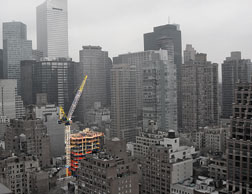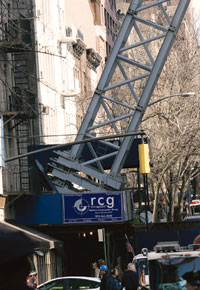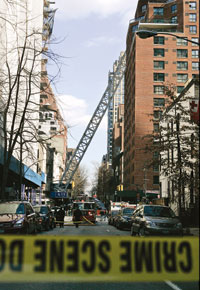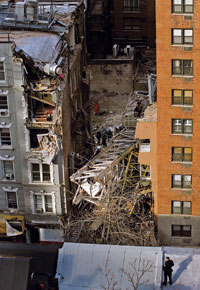 Reliance Construction Group Marketing photo from construction-management firm shows tower crane last month. It fell after jump to 205 ft.
|
Investigators in New York City are focusing on what happened during the jump of a 205-ft-tall tower crane on March 15 when workers apparently lost control of a six-ton bracing collar at the 18th floor during installation. Seven people died and 24 were injured, several critically, in the ensuing accident. The tower tilted away from the structure under construction, slammed into the 15th-story parapet of a building across the street, broke into pieces and sent the cab and luffing jib flipping over and crashing down through smaller buildings on the next street.
Photographic evidence appears to point to a failure of nylon webbing temporarily supporting the collar with come-alongs during installation. Experts say nylon webbing is prone to abrupt failure when it has been damaged, and the kinds of damage that can lead to such failures may require a trained inspector to spot. Forensic experts are poring over the wreckage, trying to ascertain if such a failure triggered the event.
|
The Occupational Safety and Health Administration will deliver its findings within six months, perhaps sooner, an official says. But the accident already has spurred OSHA to announce on March 18 that it will release a proposed revision of its crane-and-derrick standard this summer. It has been studying the issue for more than three years, a pace criticized by industry groups.
 AP / Wideworld
|
 AP / Wideworld
|
 AP / Wideworld Collars stacked at base of tower. Lower section fell on building across the street while upper tower, cab and luffing jib broke off and flipped into the next block, knocking the side off one building and flattening another. Six of the seven dead worked on the construction.
|
Dropping Collar
One suggested sequence of the accident involves the 18th-floor collar dropping down the crane tower, manufactured by Favelle Favco Cranes (USA) Inc., Harlingen, Texas. The steel ring then knocked the ninth-floor collar from its braces and drove them both into the collar on the third floor. Photographs from the scene show three collars stacked on top of each other near the street level on the tilting tower base. On the top collar, parted webbing and come-alongs are still attached. A representative from Favelle Favco Cranes did not respond to requests for comment or information about recommended collar-installation procedures.
RCG Group, Parsippany, N.J., the U.S. division of Reliance Construction Group, Montreal, is pre-construction and construction manager on the 46-story, 240-unit condominium project served by the crane. The owner is Kennelly Development Co. LLC, New York City. RCG released a statement expressing “our deepest sympathies to the families of the victims and to those who have been injured as part of this devastating accident.” It pledged full cooperation with all agencies involved. It noted, however, that it had subcontracted the work at the site. That subcontractor is Joy Contractors Inc., Elizabeth, N.J. Attempts to reach the company for comment were unsuccessful. RCG says the crane was supplied by New York Crane & Equipment Corp., Brooklyn, N.Y. RCG says it has launched an internal investigation. “We believe it is prudent not to comment further at this time,” the company’s statement concludes.
James F. Lomma, principal of New York Crane & Equipment, confirms a synthetic sling appears to have failed while a renter was jumping one of his Favco M440 tower cranes, but he would not speculate further. “I really don’t know 100% yet,” says Lomma. “We are just waiting for the investigation to be completed.”
When asked about nylon slings, Lomma says, “I personally don’t like nylon slings...you can cut them very easily.” He also notes that he rents cranes in New York City “bare,” meaning without operator or maintenance crew. It is up to the contractor to ensure the work is done safely and according to local code, he says. Having a factory representative on site during a jump is standard, says Lomma except in New York City, where the presence of a master rigger is required.
Wide Impact
Investigators at the accident site were not commenting on the inquiry, but crane experts elsewhere are following it closely. Crane inspector Greg Teslia, president of Crane Safety & Inspections Inc., Coral Springs, Fla., says the falling-collar scenario sounds plausible. “That collar on that crane is very large,” he notes. “Normally they will have three pieces of it already assembled and fly that up at one time, secure it to the crane with big safety cables and then get the fourth piece that completes the collar.”
Teslia says the accident also bears similarities to an April 2006 tower-crane accident in Miami that he investigated: A piece of climbing gear dropped during a jumping...
 Related Links:
Related Links: 
Post a comment to this article
Report Abusive Comment